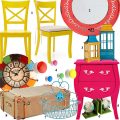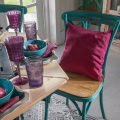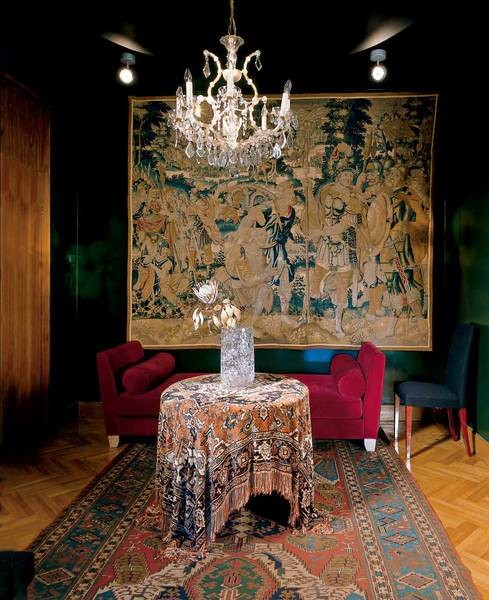 Art objects1. MODEL THE SITUATION BY LIGHT! Thanks to directed theatrical lighting, the pearls of your collection will not go unnoticed. If too bright rays are harmful to them, you can choose a workaround, following the example of Afisha publisher Andrew Paulson. In the hall of his apartment, the soffits are directed not to a 16th-century tapestry, but to a chandelier hanging next to each other. Light falls on the precious canvas, reflected from its crystal pendants, and the shaded corners of the room only accentuate the dramatic nature of the mise-en-scene.
Art objects1. MODEL THE SITUATION BY LIGHT! Thanks to directed theatrical lighting, the pearls of your collection will not go unnoticed. If too bright rays are harmful to them, you can choose a workaround, following the example of Afisha publisher Andrew Paulson. In the hall of his apartment, the soffits are directed not to a 16th-century tapestry, but to a chandelier hanging next to each other. Light falls on the precious canvas, reflected from its crystal pendants, and the shaded corners of the room only accentuate the dramatic nature of the mise-en-scene. 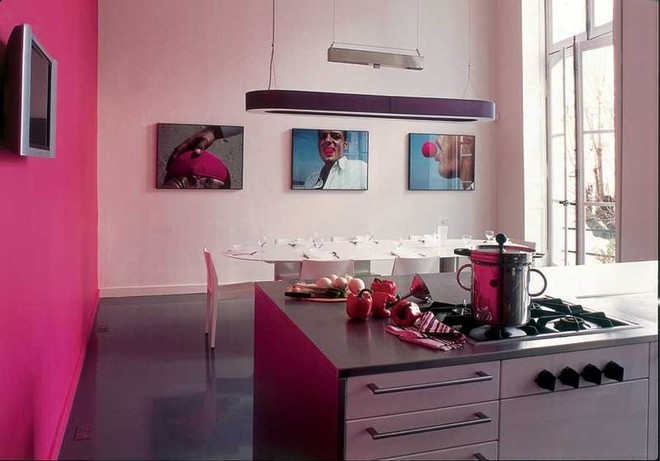 Art objects in the interior2. START FROM THE END! A place for works of art is usually chosen when the repair in the apartment is already completed. But if you go on the contrary, the result will be much more interesting. Thus, the Paris decorators Pauline Manse and Francois-Xavier Bourgeois arrived. Images from the film Annika Larson prompted them to color the whole interior. On each of the three shots there was a fuchsia-colored ball. Balls and encouraged designers to think of dyeing one of the walls in this color. And glossy paint, which reflects light well and throws crimson reflexes on all objects around.
Art objects in the interior2. START FROM THE END! A place for works of art is usually chosen when the repair in the apartment is already completed. But if you go on the contrary, the result will be much more interesting. Thus, the Paris decorators Pauline Manse and Francois-Xavier Bourgeois arrived. Images from the film Annika Larson prompted them to color the whole interior. On each of the three shots there was a fuchsia-colored ball. Balls and encouraged designers to think of dyeing one of the walls in this color. And glossy paint, which reflects light well and throws crimson reflexes on all objects around.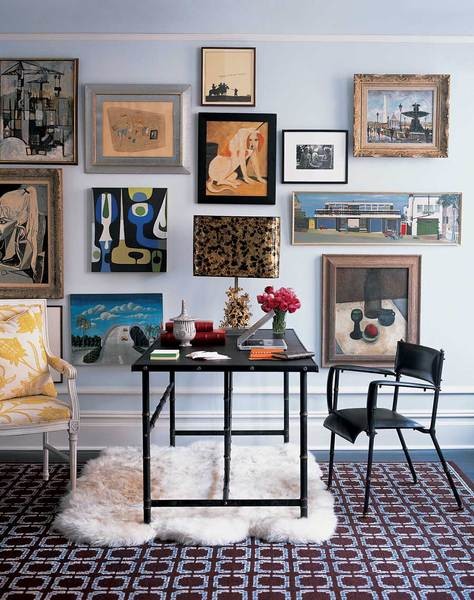 3.DO NOT DISSOLVE TRADITION! If the tapestry hanging was actively used in the 19th century, this does not mean that the system is outdated by the 21st century. On the contrary, today it is very popular due to the fact that it looks easy. But keep in mind: hanging pictures so that they look good together is much more difficult than it seems at first. If in doubt, follow the example of the owner of this Manhattan apartment - consult a designer or gallery owner.
3.DO NOT DISSOLVE TRADITION! If the tapestry hanging was actively used in the 19th century, this does not mean that the system is outdated by the 21st century. On the contrary, today it is very popular due to the fact that it looks easy. But keep in mind: hanging pictures so that they look good together is much more difficult than it seems at first. If in doubt, follow the example of the owner of this Manhattan apartment - consult a designer or gallery owner.  4. DO NOT BE AFRAID OF THE ACTIVE BACKGROUND! Until recently, neutral white walls were considered an ideal background for art objects. They only needed one thing - not to interfere. Nobody denies the classical clarity of this position, but times change. Today, the background can not only accompany the work, but also enter into an active dialogue with him, as happened in the apartment of fashion historian Tiffany Dyubin. At first glance, a wall with wide purple stripes is not the best addition to painting. But Tiffany thought differently. In fact, both furniture and accessories - everything in this room is in close contact with the picture. If this contact becomes unnecessarily importunate, it can always be interrupted by rolling down the walls with white paint!
4. DO NOT BE AFRAID OF THE ACTIVE BACKGROUND! Until recently, neutral white walls were considered an ideal background for art objects. They only needed one thing - not to interfere. Nobody denies the classical clarity of this position, but times change. Today, the background can not only accompany the work, but also enter into an active dialogue with him, as happened in the apartment of fashion historian Tiffany Dyubin. At first glance, a wall with wide purple stripes is not the best addition to painting. But Tiffany thought differently. In fact, both furniture and accessories - everything in this room is in close contact with the picture. If this contact becomes unnecessarily importunate, it can always be interrupted by rolling down the walls with white paint! 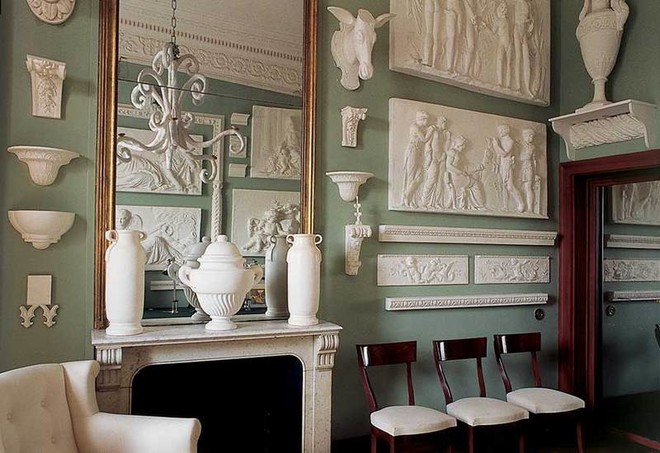 5. SHOW WHAT YOU HAVE! Any collection can become an ornament of an interior: whether it be a collection of buttons, ancient irons or thimbles. It is important to properly beat it. The ordered placement of objects with similar qualities enhances their artistic influence. Snow-white gypsum, from which copies of neoclassical cornices, vases, cartouches and garlands were cast, became the main hero of the interior of one of the rooms in the estate of the decorator Jacques Garcia. Even the upholstery of the sofa and antique English mahogany chairs supports this topic. The chandelier is made according to the design of Garcia himself, and also of plaster!
5. SHOW WHAT YOU HAVE! Any collection can become an ornament of an interior: whether it be a collection of buttons, ancient irons or thimbles. It is important to properly beat it. The ordered placement of objects with similar qualities enhances their artistic influence. Snow-white gypsum, from which copies of neoclassical cornices, vases, cartouches and garlands were cast, became the main hero of the interior of one of the rooms in the estate of the decorator Jacques Garcia. Even the upholstery of the sofa and antique English mahogany chairs supports this topic. The chandelier is made according to the design of Garcia himself, and also of plaster! 6. IRONIZE! It is not necessary to experience awe before the work of art. You can make fun of him. Look at what royal meal was prepared by the decorators Roland de Bevijon and Maurice Savinel for the "King of the hares" by Mireille Mardero. Moreover, he hangs not somewhere, but in the dining room!
6. IRONIZE! It is not necessary to experience awe before the work of art. You can make fun of him. Look at what royal meal was prepared by the decorators Roland de Bevijon and Maurice Savinel for the "King of the hares" by Mireille Mardero. Moreover, he hangs not somewhere, but in the dining room!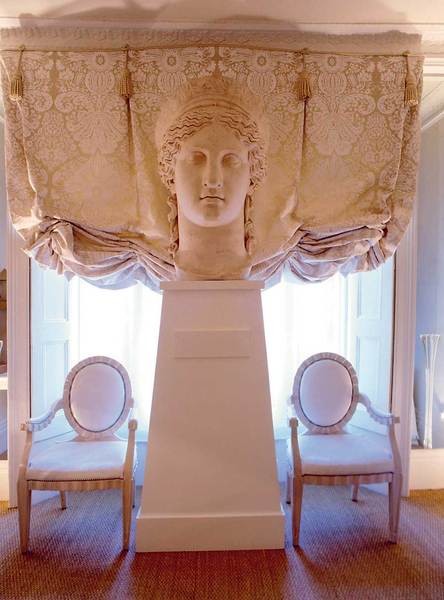 7. PLAY WITH SCALE! Forget the words "this picture / sculpture / engraving is too large / small for my room". Nothing so much affects a person as a shift in the familiar coordinate system. It's just that you need to be able to manipulate. Some gigantic wooden horse does not necessarily "crush" a small bedroom. He can completely transform it. Designer Stephen Ryan was not afraid to plant in the living room of his London home a giant pedestal with a giant bust. At first sight you understand that before you - great art! In all senses of the word.
7. PLAY WITH SCALE! Forget the words "this picture / sculpture / engraving is too large / small for my room". Nothing so much affects a person as a shift in the familiar coordinate system. It's just that you need to be able to manipulate. Some gigantic wooden horse does not necessarily "crush" a small bedroom. He can completely transform it. Designer Stephen Ryan was not afraid to plant in the living room of his London home a giant pedestal with a giant bust. At first sight you understand that before you - great art! In all senses of the word.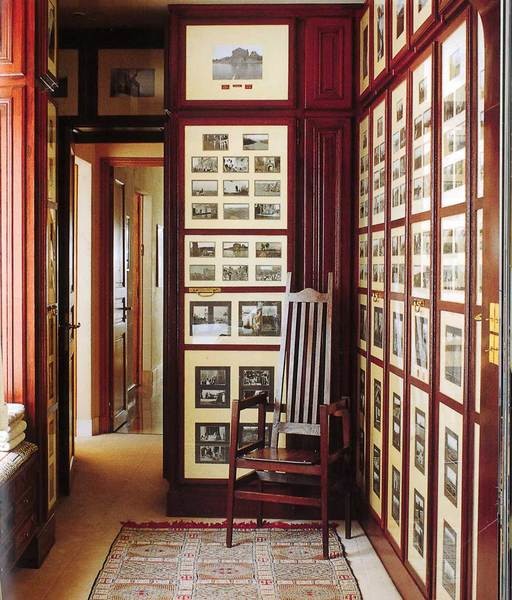 8. DO NOT BE AFRAID TO REPEAT! If your collection contains many works of the same format - for example, engravings or photographs - they can be used in a new quality as a kind of decorative material. In the dressing room of the French designer Hubert le Gall, the rhythm is set by vintage photographs with the views of Morocco from the album that he bought at an auction in the "Drouot Hotel". The owner simply inserted them into the mat and attached them to the glass doors of the built-in closets on the inside.
8. DO NOT BE AFRAID TO REPEAT! If your collection contains many works of the same format - for example, engravings or photographs - they can be used in a new quality as a kind of decorative material. In the dressing room of the French designer Hubert le Gall, the rhythm is set by vintage photographs with the views of Morocco from the album that he bought at an auction in the "Drouot Hotel". The owner simply inserted them into the mat and attached them to the glass doors of the built-in closets on the inside.

Making Money with Desserts: Success Stories
Yevhen Polishchuk (Fedutinov) instagram: @ evgeniyafedutinovavk.com / janeshomebaking– It all started with baking for relatives and friends. Gradually, she began uploading photos of her baking to Instagram, and orders began to come in. I made my first cake to order on October 13, 2014, and a little earlier I started making macarons and cupcakes. We can say that the business "found me myself", I am very [...]

Soups are cold recipes with photos
Cold cucumber soup with yogurt and lemonSorbet from La Taverna restaurant chef Alexander Zhurkina Photo: Getty Images Ingredients: Yoghurt without additives - 125 gCucumber - 150 gSorbet lemon / lime - 50 gCool shrimp - 24 gFresh ginger - 1 gLime lime - 5 gFresh orange juice - 5 gPetroshka - 1 g pink - 1 gCress salad - […]

barbeque kebab
Pork tenderloin glaze Photos: Dmitry Bayrak / dbstudio Cooking time: 20 minutes + time for pickling. Calorie content: 454 kcal per 1 serving. For 4 servings: 4 pork tenderloin (about 300 g each), 1 onion, 2 cloves of garlic, 1 tsp. lemon peel, 1 tsp. lemon juice, a pinch of ground cumin, coriander and turmeric, 1 tbsp. l vegetable [...]

Pierre Duacan: dietary recipes: Ducane diet
Beetroot Photo: Season'S, Luxury Hotels Representation You will need: · Boiled beets - 60 g · Fresh cucumbers - 20 g · Red radish - 20 g · Green onions - 10 g · Egg - 1 pcs · Mineral drinking water - 200 g · Salt - 1 g Ready: · Boil egg and beetroot. · Grind cucumbers, radishes and a part of beets. Putting everything [...]


